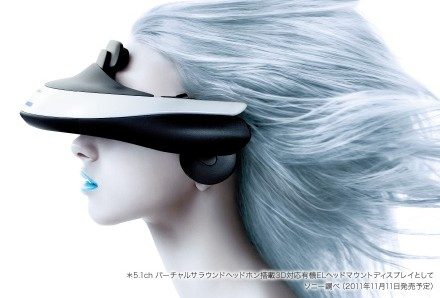 Sony is launching a head mounted display (HMD) come 11/11, and it’s likely to be one of the highest quality and most consumer-available HMDs to date.
Sony is launching a head mounted display (HMD) come 11/11, and it’s likely to be one of the highest quality and most consumer-available HMDs to date.
The HMD, for which Sony is already taking pre-orders, will go on retail for $799. Before you scoff at the price, let’s take a minute to see exactly what you’re paying for:
The HMZ-T1, or “Personal 3D Viewer” as Sony is calling it in the US (catchy, I know), has two high definition (720p {1280×720}) OLED displays. OLED technology is capable of achieving far deeper blacks than you’re typical LCD HDTV. Because there is one display for each eye, 3D is easy to provide (just supply slightly different perspective to each eye and the brain will figure out the rest). Also, because the images are so close, Sony says that wearing the headset is equivalent to watching a 150″ display from 12 feet away. There’s also ear pieces (that I’m hoping will be quite high-quality) which have support for virtual 5.1 surround sound.
So when you see that you’re essentially getting a one-person 150″ 3D 720p OLED HDTV with virtual 5.1 surround sound, $799 doesn’t seem to ridiculous.
The biggest advantage of the HMD for VR purposes will be the sensory isolation. One of the most important parts of achieving immersive virtual reality is making it easy for the user to forget their actual reality. By isolating the screens so that you can see nothing else, and providing audio directly to the ears, this HMD will make it very easy to get immersed in the digital word that you’re viewing.
Obviously this launch has huge implications for early VR gaming. Sony, if you somehow didn’t know, makes the PS3, which already has support for 3D gaming; this HMD will be perfectly compatible with any existing and future 3D games. I can easily see Sony bundling the PS3 with the sale of the HMZ-T1 at some point because the PS3 is a perfect platform for getting content to the HMD. It’s unlikely because of the price, but if the HMZ-T1 became very popular, you might see PS3 game developers designing games specifically with the headset in mind.
The PS3 already supports the Move, Sony’s motion-gaming gamit — sensors inside the Move allow the orientation of the unit to be tracked. Sony already has this technology in a product that’s on the market; embedding these sensors directly into a special gaming version of the HMZ-T1 shouldn’t be difficult or raise the cost significantly.
With such sensors, someone playing a game could wear the HMD then use their head to look around the environment, instead of relying on something that I’ll call ‘unintuitive input’. I’m defining ‘unintuitive input’ as “input from a real component that controls something other than a virtual incarnation of that component.” For instance, a thumb being used as input to control the direction that a virtual character is looking would be unintuitive input, whereas using one’s head to control where the character is looking would be ‘intuitive input’.
Currently, the state of gaming relies almost exclusively on unintuitive input. As we travel further down the road to virtual reality, intuitive input systems will become increasingly popular as they are vital to creating immersion. We’ve got all the pieces to the puzzle for HMD-based intuitive input, someone just needs to put the puzzle together in a cost effective and mainstreamable way. Maybe Sony will be the ones to do this as they bring the cost of such HMDs down.







Pingback: Make Your Own Head Mounted Display With an Android Phone « Road to Virtual Reality()
Pingback: Sony’s HMZ-T1 Head Mounted Display Launching Early in the US? « Road to Virtual Reality()
Pingback: The Road to Virtual Reality Will Not Be Walked Without Opposition « Road to Virtual Reality()
Pingback: Alternatives to Sony’s HMZ-T1 Head Mounted Display « Road to Virtual Reality()
Pingback: Interactive Virtual Reality Movies Will Combine Film and Games to Create Highly Immersive Narratives « Road to Virtual Reality()
Pingback: Sony HMZ-T1 HMD Documentation Goes Online Early, Useful Info Revealed « Road to Virtual Reality()
Pingback: Sony Turning Away from Mainstream VR? New HMD is Designed for Surgery()
Pingback: Road to VR is 3 Years Old, We Take a Look Back - Road to Virtual Reality()